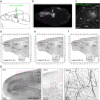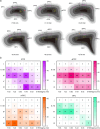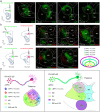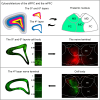Depicting Primate-Like Granular Dorsolateral Prefrontal Cortex in the Chinese Tree Shrew
- PMID: 39455280
- PMCID: PMC11514722
- DOI: 10.1523/ENEURO.0307-24.2024
Depicting Primate-Like Granular Dorsolateral Prefrontal Cortex in the Chinese Tree Shrew
Abstract
It remains unknown whether the Chinese tree shrew, regarded as the closest sister of primate, has evolved a dorsolateral prefrontal cortex (dlPFC) comparable with primates that is characterized by a fourth layer (L4) enriched with granular cells and reciprocal connections with the mediodorsal nucleus (MD). Here, we reported that following AAV-hSyn-EGFP expression in the MD neurons, the fluorescence micro-optical sectioning tomography revealed their projection trajectories and targeted brain areas, such as the hippocampus, the corpus striatum, and the dlPFC. Cre-dependent transsynaptic viral tracing identified the MD projection terminals that targeted the L4 of the dlPFC, in which the presence of granular cells was confirmed via cytoarchitectural studies by using the Nissl, Golgi, and vGlut2 stainings. Additionally, the L5/6 of the dlPFC projected back to the MD. These results suggest that the tree shrew has evolved a primate-like dlPFC which can serve as an alternative for studying cognition-related functions of the dlPFC.
Keywords: dorsolateral prefrontal cortex (dlPFC); fourth layer (L4); granular cell; medial prefrontal cortex (mPFC); mediodorsal nucleus (MD); orbital frontal cortex (OFC); primate; tree shrew.
Copyright © 2024 Nie et al.
Conflict of interest statement
The authors declare no competing financial interests.
Figures







Similar articles
-
Regional Specialization of Pyramidal Neuron Morphology and Physiology in the Tree Shrew Neocortex.Cereb Cortex. 2019 Dec 17;29(11):4488-4505. doi: 10.1093/cercor/bhy326. Cereb Cortex. 2019. PMID: 30715235
-
Finding prefrontal cortex in the rat.Brain Res. 2016 Aug 15;1645:1-3. doi: 10.1016/j.brainres.2016.02.002. Epub 2016 Feb 8. Brain Res. 2016. PMID: 26867704 Review.
-
Do rats have prefrontal cortex? The rose-woolsey-akert program reconsidered.J Cogn Neurosci. 1995 Winter;7(1):1-24. doi: 10.1162/jocn.1995.7.1.1. J Cogn Neurosci. 1995. PMID: 23961750
-
Two contrasting mediodorsal thalamic circuits target the mouse medial prefrontal cortex.J Neurophysiol. 2024 May 1;131(5):876-890. doi: 10.1152/jn.00456.2023. Epub 2024 Apr 3. J Neurophysiol. 2024. PMID: 38568510 Free PMC article.
-
Do rats have a prefrontal cortex?Behav Brain Res. 2003 Nov 30;146(1-2):3-17. doi: 10.1016/j.bbr.2003.09.028. Behav Brain Res. 2003. PMID: 14643455 Review.
References
-
- Brodmann K (1909) Vergleichende Lokalisationslehre der Grosshirnrinde in ihren Prinzipien dargestellt auf Grund des Zellenbaues. Lepzig: Barth.
-
- Buettner-Janusch J (1963) Evolutionary and genetic biology of primates. London and New York: Academic Press.
-
- Cai JX, Xu L, Hu XT, Ma YY, Su W, Xiao KY (1993) The relation between evolution of spatial working memory function and of morphology of the dorsolateral prefrontal cortex among the rhesus monkey, slow loris and tree shrew. Zool Res 14:158–165.
MeSH terms
LinkOut - more resources
Full Text Sources
